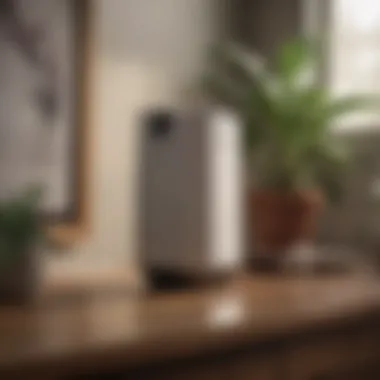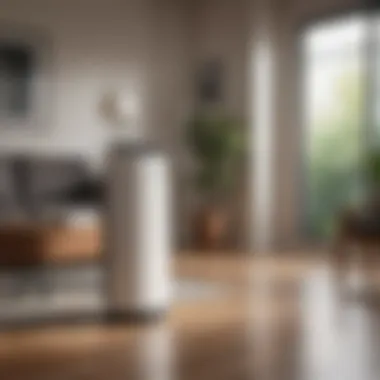Affordable Air Purifiers for Allergy Relief


Intro
In today’s world, high levels of air pollution and allergens have led to an increasing number of people suffering from allergies. These can stem from various sources such as dust mites, pet dander, pollen, and mold spores. Many individuals seek relief through air purifiers. However, the market is flooded with options, and finding the right one without overspending can be a daunting task. This article focuses on air purifiers under $100 and will describe their effectiveness in alleviating allergy symptoms.
We examine key features such as filtration technology, room size coverage, noise levels, maintenance, and energy efficiency. By analyzing these factors, readers can make informed decisions on which air purifiers best suit their needs. Additionally, we provide insights into selecting the right model based on specific allergens, ensuring that individuals can breathe easier at home.
Design Inspiration
Air purifiers, while primarily functional, need not be an eyesore in your home. Many manufacturers understand the importance of aesthetics and have begun to design products that blend seamlessly with modern interiors.
Trending Styles
Air purifiers are increasingly available in various styles. Some are compact and minimalist, making them perfect for smaller spaces. Others feature sleek designs that resemble modern art pieces, suitable for open-plan living areas. Look for options that incorporate materials like wood or brushed metal to achieve a more refined look. This will allow the purifier to integrate naturally into your home décor rather than stand out awkwardly.
Color Palettes
When selecting an air purifier, consider color as it affects the overall look of the space. Common colors include white, black, or gray, which tend to match easily with any design style. However, some brands also offer vibrant colors or unique patterns for added character. Choosing a color that complements your interior can enhance the visual appeal while maintaining functionality.
Practical Tips
For those investing in an air purifier, being strategic can maximize benefits.
Maintenance & Care
A well-maintained air purifier performs significantly better. Most models come with filters that require regular replacement every 3 to 6 months. Keep an eye on the filter indicator, if available. Cleaning the device's exterior regularly with a damp cloth prevents dust accumulation and enhances its longevity.
Budgeting & Planning
When considering pricing, ensure the total cost of ownership fits within your budget. Look beyond just the initial purchase price. Consider ongoing expenses like replacement filters and electricity costs. Setting aside funds annually for these expenses can help manage your budget effectively, ensuring your air purifier continues to function well without unexpected costs.
In summation, finding the right air purifier does not require an endless budget. By examining different facets and styles, homeowners can pinpoint the best solution for allergy relief. The following sections will dive deeper into specific models, comparing features to find the ideal match for your specific needs.
Prologue to Air Purifiers
Air purifiers are becoming increasingly vital for households, especially for those who suffer from allergies. The benefits of having clean air can’t be overstated. Poor air quality has a direct impact on health and well-being. For individuals sensitive to allergens, investing in a good air purifier is crucial. In this article, we will explore various air purifiers available for under $100, clarifying their features and advantages.
Understanding Air Quality
Air quality refers to the cleanliness of the air we breathe. It is influenced by indoor pollutants such as dust, pet dander, pollen, and mold spores. Many people are not aware of how these allergens affect daily life. They can lead to respiratory problems, headaches, and fatigue. A decrease in air quality can exacerbate these issues. Important factors defining air quality include particulate matter levels, volatile organic compounds, and humidity. Understanding these factors allows homeowners to make informed choices about air purifiers.
Importance of Air Purifiers for Allergies
Air purifiers serve a significant role in alleviating allergy symptoms. They filter out airborne allergens, which helps create a healthier living space. For example, HEPA filters are designed to trap extremely small particles, offering effective relief. With more individuals spending time indoors, the need for clean air has never been more crucial.
"Investing in an air purifier can drastically improve indoor air quality and overall health."


By using air purifiers, homeowners can reduce the presence of allergens in their homes. This leads to fewer allergy attacks and better sleep. Choosing the right model becomes an essential task, especially when on a budget. The next sections will delve into specific features and qualities to look for in budget-friendly air purifiers. Understanding these elements is key to making a smart purchasing decision.
Key Features to Consider
When selecting an air purifier, especially one targeting allergies, understanding the key features is crucial. Not all air purifiers are created equal. Different models vary in efficiency, design, and cost. Keeping your budget under $100 adds another layer of consideration. Focusing on filtration technology, coverage area, noise levels, energy efficiency, and maintenance requirements will lead to a more informed decision.
Filtration Technology
The filtration technology is fundamental. It determines how effectively an air purifier removes allergens from the air. Various filters serve distinct purposes, and understanding their differences can help in selecting the right one for your needs.
HEPA Filters
HEPA (High-Efficiency Particulate Air) filters are among the most effective options for trapping small particles. They can capture 99.97% of particles as small as 0.3 microns. This makes HEPA filters a popular choice for allergy sufferers.
The key characteristic is their ability to trap allergens like dust mites, pollen, and pet dander. A significant advantage of HEPA filters is their proven effectiveness in improving indoor air quality. However, they often need replacement every 6 to 12 months, which can become an added expense.
Activated Carbon Filters
Activated carbon filters focus on adsorbing odors and gaseous pollutants. The unique feature of these filters is their porous structure, which traps harmful chemicals and smells.
While they are beneficial for improving air freshness, their efficiency against solid particles is lower compared to HEPA filters. Some models combine both HEPA and activated carbon filters, providing a comprehensive solution. The downside is potential increased replacement costs and maintenance complexity.
Pre-Filters
Pre-filters add another layer of filtration. They capture larger particles like hair and dust before they reach the main filter, enhancing the lifespan of HEPA and activated carbon filters.
This characteristic is especially useful for homes with pets. Pre-filters are easy to clean and often washable, making them a cost-effective option. However, they do not replace the need for primary filters, so regular maintenance is still necessary.
Coverage Area
The coverage area indicates how effectively an air purifier can clean the air in a room. Different air purifiers are designed for rooms of various sizes. Selecting the right size is essential for effective allergen removal.
Small Rooms
Small room air purifiers are compact and suitable for spaces up to 200 square feet. Their key characteristic is portability, often lightweight and easy to move around. This makes them ideal for bedrooms or offices. A disadvantage may be their lower airflow capacity, which means they may not be as effective in larger spaces.
Medium Rooms
Medium room purifiers typically cover areas between 200 to 400 square feet. They strike a balance between size and efficiency, making them versatile choices for most average-sized rooms in a home. However, their dimensions might hinder placement in tighter spaces.
Large Rooms
Large room air purifiers cover areas beyond 400 square feet. Their high capacity ensures better air quality in bigger spaces such as living areas. The primary benefit is their ability to purify air in a short time. Yet, they can come at a higher initial cost, and their energy consumption may be higher as well.
Noise Levels
Noise can be a significant consideration, especially when placing the purifier in a bedroom or study. Lower decibel levels are essential for a quieter operation. Many models offer multiple fan speeds, allowing users to adjust noise levels based on preference. Choosing a noiseless device can lead to a more peaceful living environment.


Energy Efficiency
Energy efficiency is vital for long-term savings. Many air purifiers are rated by their Energy Star certification. This rating indicates a product's energy efficiency, helping reduce electricity costs without sacrificing performance. Look for models that consume less energy while still delivering effective purification.
Maintenance Requirements
Maintaining an air purifier effectively ensures optimal performance. Regular maintenance checks are essential, and these involve filter replacement and general cleaning.
Filter Replacement
Filter replacement is crucial in keeping an air purifier functioning. Most HEPA filters require replacement every 6 to 12 months, depending on usage. The frequency of replacement may increase in highly polluted environments or homes with pets. This characteristic makes understanding individual models’ needs necessary.
Cleaning
Cleaning the air purifier itself is essential as well. Most models come with washable pre-filters, which reduces debris buildup and improves efficiency. However, owners must adhere to the manufacturer's care instructions to avoid damage. The effort put into maintenance will yield better performance and longer equipment lifespan.
Allergen-Specific Solutions
Understanding specific allergens is crucial when choosing an air purifier. Each type of allergen, such as dust mites, pollen, pet dander, and mold spores, requires different filtration approaches. By targeting the unique characteristics of these allergens, homeowners can effectively minimize their symptoms and improve their indoor air quality. A tailored solution not only enhances comfort but also significantly contributes to overall well-being.
Dust Mites
Dust mites are microscopic organisms that thrive in household environments, particularly in bedding, upholstery, and carpets. They feed on dead skin cells from humans and pets, creating waste that can trigger allergic reactions. This waste contains proteins that lead to sneezing, runny noses, and asthma attacks.
An effective air purifier for dealing with dust mites should have a HEPA filter that can trap particles of this size. It is also important to ensure that the air purifier is adequate for the room size where the dust mites are most prevalent. Regular cleaning and vacuuming will help reduce dust mite populations, but a solid air purifier acts as a secondary line of defense.
Pollen
Pollen is another common allergen that can be particularly problematic during the spring and summer months. It becomes airborne through wind and can easily infiltrate homes. For individuals sensitive to pollen, spending time indoors might still expose them to these irritants.
To combat pollen effectively, look for air purifiers that feature HEPA filters or activated carbon filters. These filters can capture larger pollen particles and adsorb any associated smells. Moreover, it's beneficial to place an air purifier in living areas where you spend the most time, like the living room or bedroom, to ensure a consistent level of clean air.
Pet Dander
Pet dander, small flakes of skin shed by cats, dogs, and other pets, is a leading cause of allergic reactions in sensitive individuals. This allergen can linger in the air for extended periods, making effective removal essential for pet owners who also suffer from allergies.
Choosing an air purifier that specifically addresses pet dander requires a model with a HEPA filter, as it efficiently traps these tiny particles. Moreover, regular grooming and cleaning around pets can help reduce the overall dander in your home. Combining these strategies with a reliable air purifier yields better results.
Mold Spores
Mold spores thrive in damp environments and can trigger allergic reactions or even respiratory issues. They can multiply quickly in areas with high humidity, such as bathrooms and basements. Controlling mold spores is vital to maintaining optimal indoor air quality.
An air purifier with HEPA and activated carbon filters is effective for capturing mold spores. Activated carbon helps reduce odors caused by mold, while HEPA filters trap the spores themselves. It is important to also maintain low humidity levels in your home to deter mold growth, as an air purifier alone may not eliminate the source of the problem.
Key Takeaway: Selecting an air purifier that targets specific allergens enhances the effectiveness of your home’s air quality management. Understanding each allergen's nature guides you to the air purifier that best fits your needs.
Top Air Purifiers Under $100


Choosing an air purifier can be daunting, especially with a wide range of options available. Selecting products in the under $100 range is crucial for individuals managing allergies on a budget. These machines can effectively reduce allergens, improve indoor air quality, and offer a sense of relief for allergy sufferers. Balancing cost with features becomes the main focus when exploring these options. Factors like filtration technology, noise levels, and maintenance should be considered carefully to make informed choices.
Model Reviews
Model One: Features and Benefits
One notable air purifier is the Levoit LV-32. This model is designed for small to medium-sized rooms. It utilizes a three-stage filtration system, which includes a true HEPA filter, improving its effectiveness against airborne allergens. The key aspect of the Levoit LV-32 is its compact size. This makes it very convenient for small spaces, such as bedrooms or offices. One unique feature is the night light option, which can enhance nighttime usability.
While it is popular due to its performance and affordability, some users find that the fan noise can be a bit intrusive at higher settings. Overall, the Levoit LV-32 offers solid filtration capabilities for its price point and remains a popular choice in the market.
Model Two: Features and Benefits
Next is the Hathaspace HSP001. This air purifier stands out for its smart features. It has a built-in air quality sensor and can automatically adjust its settings based on the detected air quality. Its eight-in-one air cleaning system captures dust, pet hair, smoke, and other allergens effectively. The most significant point of the Hathaspace HSP001 is the user-friendly interface. The display shows real-time air quality feedback, which is motivating for maintaining better air conditions.
A potential downside is its slightly higher power consumption compared to other models. However, many users appreciate its effectiveness and innovative features, making it a potent contender for allergy relief under the $100 threshold.
Model Three: Features and Benefits
Lastly, the TaoTronics TT-AP001 deserves attention. Known for its portability, this model is lightweight and ideal for moving from room to room. Its three-layer filtration system includes a HEPA filter as well, aimed at eliminating small particulate matter. An advantage of the TaoTronics TT-AP001 is its price and versatility; it has a budget-friendly cost combined with reliable performance.
One notable feature is its sleep mode. This operates at a lower noise level, making it suitable even for light sleepers. On the flip side, it may have a little less coverage area compared to others in the same price range. Nonetheless, the TaoTronics TT-AP001 serves as an accessible option for anyone looking to enhance indoor air quality without steep investments.
Purchasing Considerations
When seeking an air purifier specifically under the price point of $100, careful consideration of several aspects is crucial. These considerations help guide potential buyers toward making informed decisions that suit their unique needs, particularly in relation to allergies. In this section, we touch on two key elements: where to buy and the significance of warranty and return policies.
Where to Buy
There are numerous avenues to acquire air purifiers, each with its own pros and cons. Understanding these options can significantly impact both price and selection variety.
- Online Retailers: Websites like Amazon, Walmart, and eBay frequently offer a wide range of air purifiers at competitive prices. Shopping online allows for easy price comparisons and often provides customer reviews for each product. These can be insightful, helping you assess the performance and reliability of specific models.
- Physical Stores: Home improvement stores such as Home Depot or Lowe's also stock air purifiers. The advantage here is that you can see the product and sometimes even test the settings before purchasing. However, the selection might be limited compared to online catalogs.
- Brand Websites: Some manufacturers have direct sales through their websites. Brands like Levoit or Germ Guardian may offer exclusive deals, bundles, or promotions that are not available through retail shops.
Warranty and Return Policies
Warranties and return policies offer buyers protection and peace of mind when investing in an air purifier. When purchasing under a budget, these factors become even more critical.
- Warranty Coverage: It is essential to consider the duration and extent of coverage. A warranty of at least a year is typical for many household devices. This protects you against defects in materials or workmanship, ensuring your investment is secure. Brands like Honeywell and Dyson often provide solid warranty terms that you should read through carefully.
- Return Policies: A flexible return policy allows buyers to test the product and return it if it does not meet their expectations. Always check if there are specifics like restocking fees or conditions under which the product can be returned. For example, many retailers have a 30-day return window with full refund options, which is suitable for trying out the air purifier without long-term commitment.
In summary, navigating the purchasing landscape for air purifiers requires attention to where to purchase and understanding warranty and return policies. These factors not only affect satisfaction but also determine the overall value of your purchase.
Ending
In this article, we have explored the essential features and models of air purifiers suitable for individuals dealing with allergies, all while maintaining a budget under $100. By focusing on various factors like filtration technology, coverage area, and energy efficiency, we provided a comprehensive understanding of what to look for when selecting an air purifier. This is crucial because the right device can significantly enhance one's quality of life, reducing allergy symptoms by improving indoor air quality.
Summary of Key Points
- Filtration Technology: It is vital to choose air purifiers with proper filtration systems. HEPA filters are best for trapping smaller allergens.
- Coverage Area: Understanding the size of the room helps in selecting an air purifier that can effectively clean the air.
- Noise Levels: A quieter model can greatly improve the living environment, especially during nighttime.
- Energy Efficiency: A purifier should not only clean air but also be cost-effective in terms of energy usage.
- Maintenance Requirements: Knowing how often to replace filters can save both time and effort in the long run.
Encouragement to Evaluate Options
It’s important to take the time to evaluate your options before making a purchase. With so many models available under $100, consider your specific needs, such as the types of allergens present in your home. Researching user reviews and product specifications can lead to a well-informed decision. Take note of factors like warranty, customer service, and filter availability.
In summary, appropriate research will help ensure that your choice of an air purifier aligns well with your personal needs and budget. By doing so, you'll be investing in a cleaner and healthier living space, free from the disturbances of allergens.















